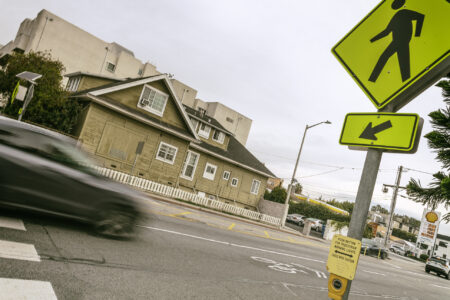
Share On Social!
Decades of decisions fueled by structural racism have built a society with no health equity, where many groups lack a fair, just opportunity to be their healthiest.
This is especially true in our transportation system.
Past and present planning, policy, and funding decisions have failed to provide equitable, affordable, safe, convenient, and reliable transportation options for all, from the local to federal levels.
Dismantling these inequities requires intentional effort.
That’s why Smart Growth America conducted a field scan to explore promising opportunities to achieve equitable public infrastructure, with support from the Robert Wood Johnson Foundation.
The report spells out the six biggest challenges to health equity facing our transportation system (and the 40 strategies to address those challenges) for transportation professionals, public health professionals, elected officials, advocates, and funders.
Each challenge is a symptom or result of structural racism in some way.
“The good news is that unlike so many public health crises that seem intractable, we have the tools to build healthy, thriving communities for all,” said Emiko Atherton of the National Complete Streets Coalition.
Download The State of Transportation and Health Equity report from Smart Growth America.
1. The Public Knows Very Little about Transportation Decision-making
Americans don’t really know how transportation decisions are made and who makes those decisions.
Media outlets also don’t understand transportation and the impact it has on health, equity, safety, and our economy. They often imply that crashes and pedestrian fatalities are inevitable.
Unfortunately, current messaging, narratives, and language to improve transportation and health equity are not working.
There are few easy-to-understand sheets to explain complicated transportation policy ideas.
Thus, policymakers are failing to understand the implications of their transportation decisions or the connection between transportation and their top priorities, like jobs, healthcare, and the economy.
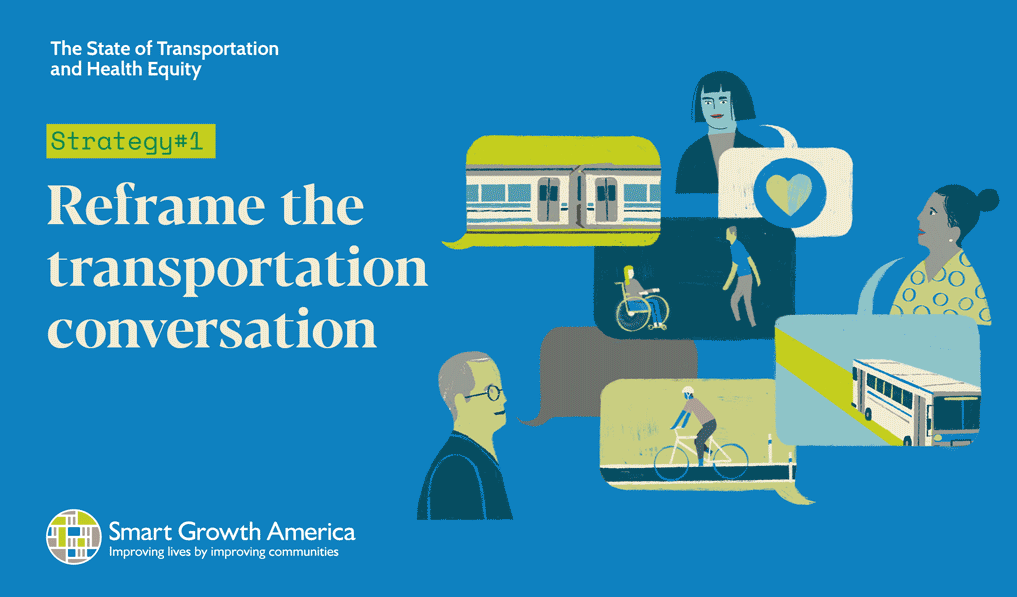 It’s time to reframe the transportation conversation, according to the Smart Growth America report:
It’s time to reframe the transportation conversation, according to the Smart Growth America report:
- Strategy 1.1: Advocates and professionals need to frame transportation and transportation solutions around values that people care about, such as having the freedom to choose how to travel.
- Strategy 1.2: Advocates need to educate the media on the impact transportation has on our communities and why our transportation system doesn’t serve everyone. Most importantly, advocates must hold the media accountable to avoid victim-blaming
- Strategy 1.3: To effectively communicate ideas and messages that build support for more equitable transportation, use trusted messengers, or individuals who are similar to the intended audience.
- Strategy 1.4: Demonstration projects, also known as tactical urbanism or quick builds, are temporary improvements that test changes to the built environment.
- Strategy 1.5: To change hearts and minds of our leaders, advocates need to lead with messages that matter to elected officials and their constituents (i.e., access to jobs).
- Strategy 1.6: Advocates and transportation professionals must create and share case studies and easy to understand fact sheets that anyone can understand.
2. Government Misallocation and Mismanagement of Funds and Resources
Each year billions of transportation dollars get spent with mainly cars in mind.
Because federal government actions set the framework for state and local governments to follow, all levels of government continue to build roads to move cars fast regardless of whether people get where they need to go in a safe, convenient, accessible, and affordable way.
For example, there are no consequences for state DOTs to setting higher target numbers for deaths and serious injuries. As a result, in 2017, 18 states set 2018 targets for non-motorized deaths and injuries that were higher than the most recent year of data reported. MPOs follow the state’s lead.
Moreover, the responsibilities and priorities of state DOTs are no longer aligned. There is a lack of transparency and accountability when it comes to how transportation money is spent and why.
Elected officials and transportation agencies use outdated metrics, tools and policies to make decisions about project prioritization and funding.
For example, how many vehicles can move through a corridor and how fast they do so are inadequate metrics.
Yet, many transportation departments continue to use design guidance and manuals that are focused on improving the movement of vehicles, not people.
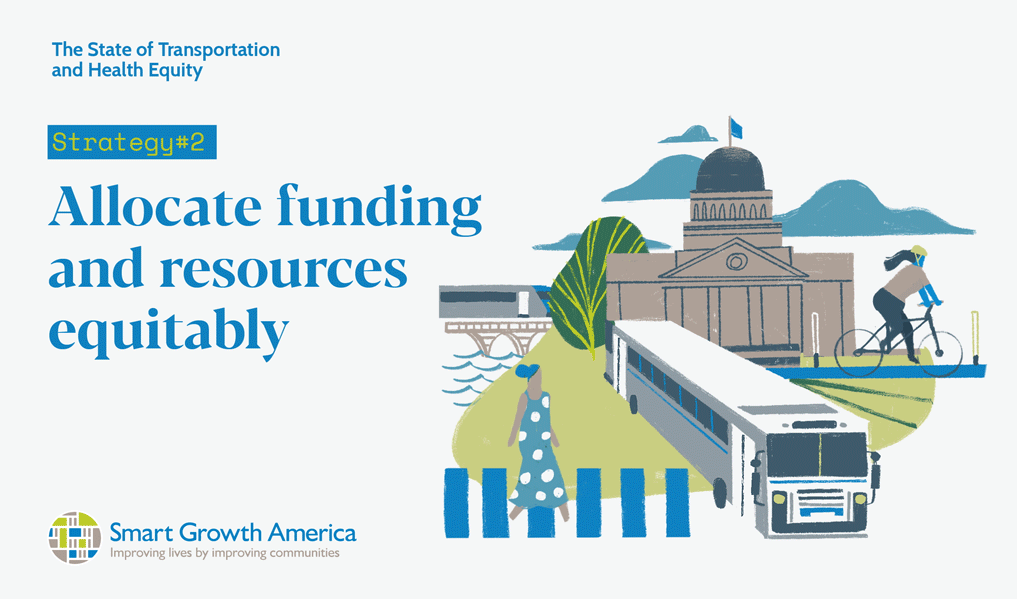 It’s time to allocate funding and resources equitably, according to the Smart Growth America report:
It’s time to allocate funding and resources equitably, according to the Smart Growth America report:
- Strategy 2.1.1: Agencies should measure the effectiveness of their transportation system and investments by how well they connect people to jobs and other essential services via public transit, passenger rail, walking and rolling, bicycling, and driving.
- Strategy 2.1.2: Federal law should require transportation agencies to redirect a portion of their highway federal funding to safety improvements, including for non-motorized users, if they see an increase in non-motorized fatalities in their states.
- Strategy 2.1.3: Pass a federal Complete Streets policy requiring state departments of transportation and metropolitan planning organizations to consider all users of the transportation system when using federal funding.
- Strategy 2.2.1: To support a multimodal transportation system, revise principles, missions, and visions to prioritize a multimodal transportation system; update procedures, standards, and staff performance evaluations to reflect those principles; and provide training to help staff thrive under the new priorities.
- Strategy 2.2.2: Agencies should be more transparent with their spending breakdowns and use tools like participatory budgeting to let the community, especially voices that have historically not been heard, decide how transportation funding should be spent.
- Strategy 2.2.3: Adopting and implementing binding Complete Streets policies and Vision Zero plans is a crucial opportunity to prioritize the needs of the most disenfranchised at the local and state level, especially where all departments are required to comply with these policies.
- Strategy 2.3.1: Transportation project performance measures need to reflect what people care about, whether that be improving health, safety, environment, or access.
- Strategy 2.3.2: The process to select transportation projects for funding should account for a project’s capacity to improve health and accessibility and improve access for all modes.
- Strategy 2.3.3: Transportation leadership should support and encourage transportation practitioners to take the time and resources to appropriately define the project scope and think more holistically about solutions to the need.
- Strategy 2.3.4: Transportation departments need to encourage their employees to use manuals, design guidelines, and tools that include designing for non-motorized users, better explain the impact transportation has on health, and provide solutions for designing and building transportation networks that improve equity.
3. Poor Decision-making and Weak Leadership
Agencies, engineers, planners, and elected officials continue to make transportation and land-use decisions that do not reflect their communities’ needs.
Transportation departments lack racial and gender diversity within their staff and leadership and continue to high and promote professionals with similar education and professional backgrounds.
Moreover, higher education institutions are not preparing transportation practitioners to fully understand the impact transportation has on public health. Many transportation professionals and decisionmakers receive very little training on planning and designing a multimodal transportation system.
Transportation agencies will not make systemic changes in how they make decisions unless they change who is making those decisions from within, while providing training on multimodal transportation systems.
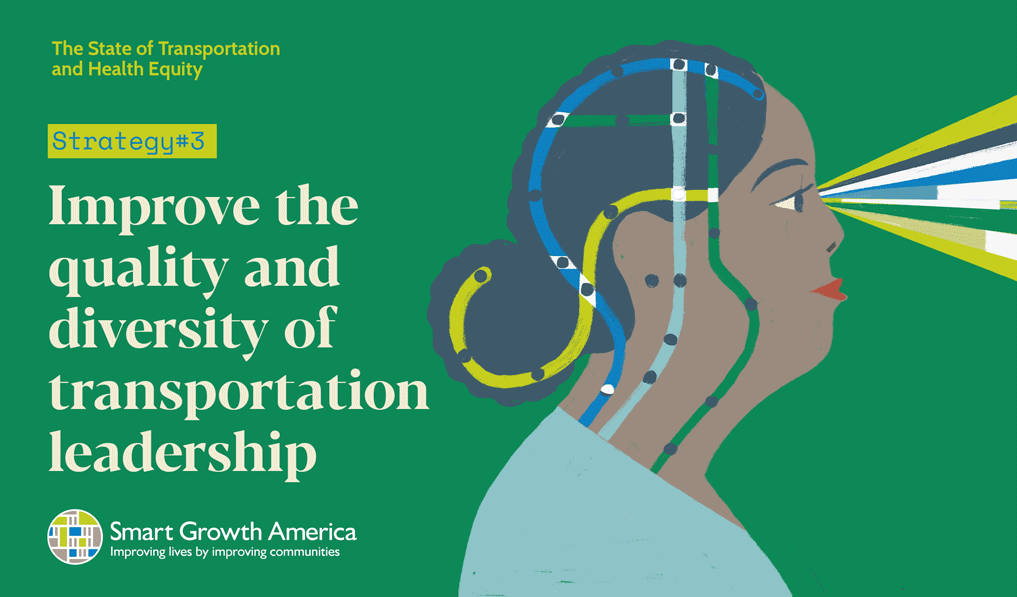 It’s time to improve the quality and diversity of transportation leadership, according to the Smart Growth America report:
It’s time to improve the quality and diversity of transportation leadership, according to the Smart Growth America report:
- Strategy 3.1: Transportation departments need to invest in long-term change by cultivating a pipeline for college and high school students to be future transportation leaders, and specifically incentivizing those who aren’t currently represented in transportation leadership.
- Strategy 3.2: Transportation agencies must improve representation in their workforce by race, gender, disability, sexual orientation, immigration, and household income.
- Strategy 3.3: Redefining expertise means valuing leaders who may not be transportation professionals by trade but are able to provide new perspectives and considerations.
- Strategy 3.4: Internal government operating policies should require their employees to attend trainings to better understand current transportation and cross-sector issues, such how to develop new transportation performance measures that match community goals.
- Strategy 3.5: Strengthen the connection between health and transportation in higher education, to include better training our engineers and planners to understand the health and equity implications of transportation decisions on the built environment.
- Strategy 3.6: Advocates should capitalize on the attention of new mobility to highlight transportation inequities and ensure that disenfranchised communities aren’t left further behind.
4. Disenfranchised Communities Have Had Very Little Power in Transportation Decision-making Process
Transportation decisions have left out some communities.
Disenfranchised communities, which have systematically been deprived of rights and privileges over time, have not had a voice to shape transportation infrastructure in their neighborhoods.
Ultimately, government structures do not value or trust the knowledge of the community, and vice versa.
Many people are not able to participate in public meetings or community engagement around a transportation project or plan. Meetings are often at inconvenient times or inaccessible places. Childcare, food, translators, and reasonable accommodations are not provided.
Transportation departments often only show up in communities either physically or electronically when they need to gather feedback rather than building sustained relationships.
Moreover, when the government and other organizations in power reach out to disenfranchised communities for feedback, they often expect community members to give their time for free, without valuing the contribution they are providing.
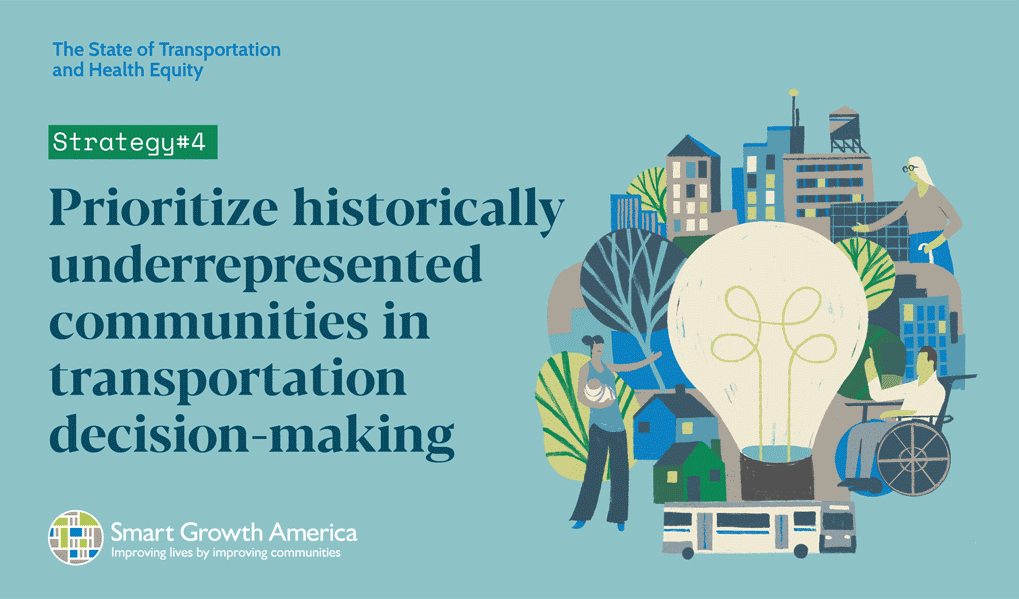 It’s time to prioritize historically underrepresented communities in transportation decision-making, according to the Smart Growth America report:
It’s time to prioritize historically underrepresented communities in transportation decision-making, according to the Smart Growth America report:
- Strategy 4.1: Transportation agencies need to rebalance decision-making power, to include changing project selection criteria to give more weight to community input.
- Strategy 4.2: Transportation agencies must remove barriers to public participation in transportation decision-making processes.
- Strategy 4.3: Both permanent employees and contracted staff should reflect the community that they are serving both demographically and geographically. Working with historically disenfranchised community groups, experts, and local champions, and compensating them for their expertise, is one way to ensure that there is equitable community representation.
- Strategy 4.4: Through shared-capacity building, provide time and space for co-learning and co-creation and committing to a transparent, long-term community engagement process
- Strategy 4.5: Use creativity and fun to deliver messages and make events more joyful, such as getting elected officials on bikes or in buses, and using found objects, like hair rollers, game pieces, and popsicle sticks to help communities members visualize and express challenges and aspirations.
5. Siloed Disciplines Prevent Holistic Solutions
At every level of government, transportation, health, housing, and planning agencies have operated in their own spheres of influence, with equity treated as an afterthought if at all.
Few elected officials understand transportation’s role in health equity.
Few transportation departments understand health. Few health departments understand transportation.
In fact, transportation decision-making is complicated and difficult to understand for elected officials, public health professionals, the public, and sometimes transportation professionals.
Transportations decisions often take a long time to translate into changes. A community or elected official may lose momentum if they cannot quickly see their work realized.
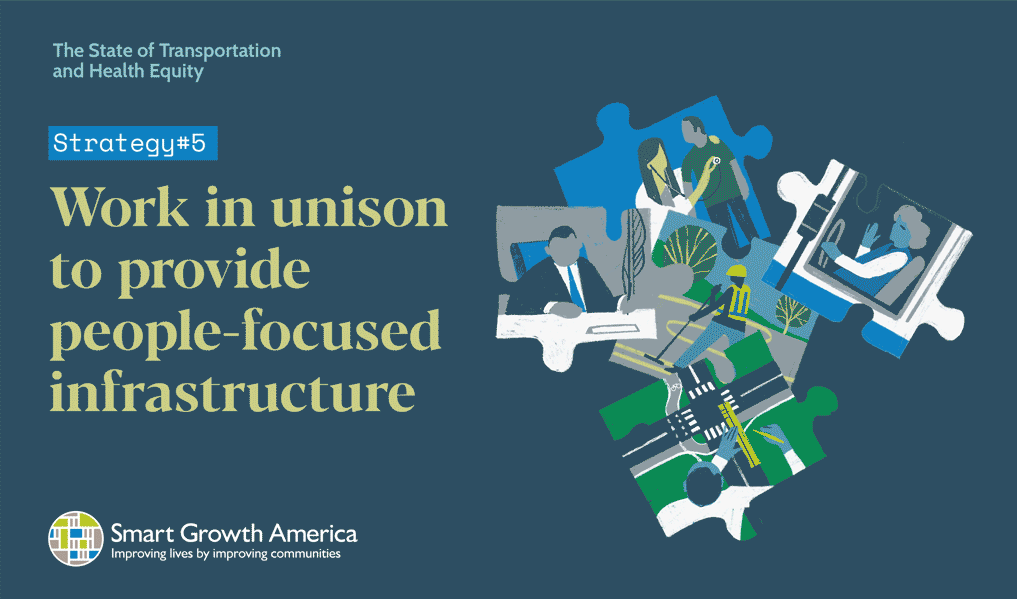 It’s time to work in unison to provide people-focused infrastructure, according to the Smart Growth America report:
It’s time to work in unison to provide people-focused infrastructure, according to the Smart Growth America report:
- Strategy 5.1: Build partnerships and relationships across disciplines to make space for community members and leaders, public health professionals, land use experts, and housing officials to shape our transportation systems.
- Strategy 5.2: Advocates should work to educate elected officials on transportation’s role in health and how it affects their constituents.
- Strategy 5.3: Create a diverse base of knowledge and skills within internal government teams. For example, hiring people with health backgrounds in transportation departments and transportation professionals in health departments.
- Strategy 5.4: Offer trainings across disciplines to build a more holistic understanding of how each sector contributes to a specific project.
- Strategy 5.5: To break down silos and make the decision-making process more accessible, simplify, avoid jargon, provide a variety of avenues on a more regular basis to share perspectives, and work closely with “translators”—people or groups who can act as connectors between other sectors, communities, and transportation professionals.
- Strategy 5.6: Agencies and organizations might consider formalizing resource sharing, like databases, maps, narratives, and analyses, across organizations by adopting data sharing agreements or other tools to improve sharing.
- Strategy 5.7: State and local DOTs should formally recognize demonstration projects as part of the project development process.
6. Displacement is the Result of Unmanaged Development and Insufficient Investment in People
The U.S. has a long history of displacing people of color in the name of prosperity.
“Improving or investing in communities—even in beneficial ways—such as improving a transit system, adding bike lanes, or investing in better pedestrian connections, often makes it more attractive to live there, which increases the market value of those neighborhoods, especially if these amenities are denied in other areas of the region,” the report states.
Without comprehensive anti-displacement prevention policies addressing modern day redlining (or “not in my backyard” opposition), low-income people or people of color will continue to be displaced.
Whether by disinvestment, reinvestment, or market competition, displacement uproots people from their homes and social support networks.
Those who are displaced are often forced to move to areas that are more affordable but lack transportation options, making it harder to get to daily destinations needed to stay healthy and move up the economic ladder.
Transportation agencies often do not consistently or holistically measure the impacts that transportation improvements will have on current residents, such as displacement.
A lack of strategic coordination between transportation, housing, and land use has resulted in households being burdened by housing and transportation costs, paying more than half of their income on the two costs combined.
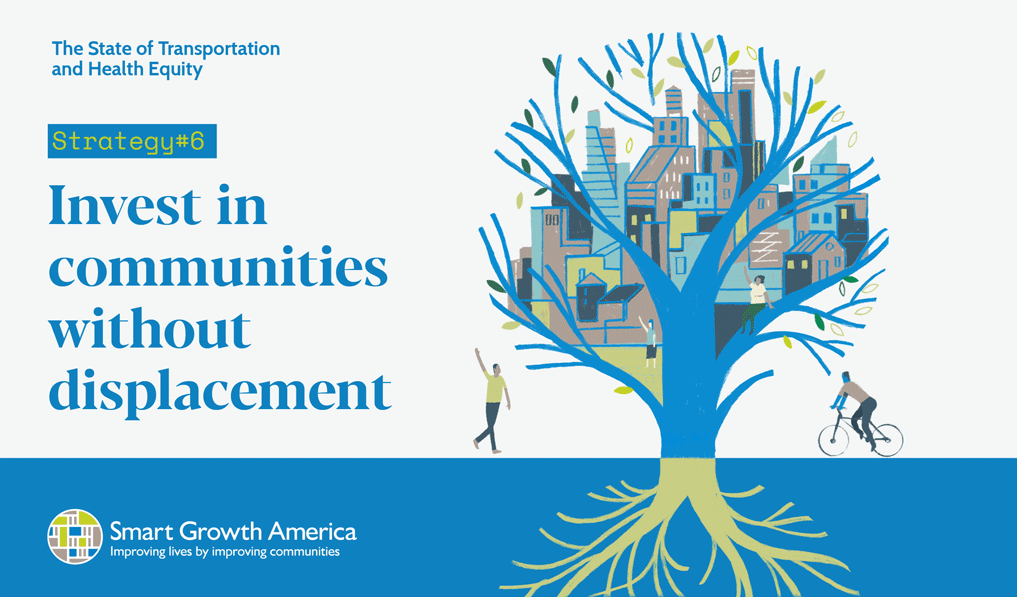 It’s time to invest in communities without displacement, according to the Smart Growth America report:
It’s time to invest in communities without displacement, according to the Smart Growth America report:
- Strategy 6.1: Measure, predict, and counteract displacements, and reward projects that allow residents to remain in place.
- Strategy 6.2: The federal government must improve guardrails on existing investment tools, like the Low-Income Housing Tax Credit, Fair Housing Act, and Opportunity Zones
- Strategy 6.3.1: Update zoning practices to encourage compact, walkable development.
- Strategy 6.3.2: Invest in equitable transit-oriented development (eTOD).
- Strategy 6.3.3: Coordinate early across sectors before transportation projects scopes and budgets are set or development decisions are finalized.
- Strategy 6.4: Any transportation investment should consider the larger economic impact on its most disenfranchised communities and take action to build shared prosperity amongst residents by using value capture tools to benefit existing residents, adopting community benefit agreements, and implementing equitable contracting and procurement.
Overall, transportation is one piece of a larger racist system that must be eliminated to fully realize health equity.
Share these strategies with transportation practitioners, public health professionals, elected officials, and community advocates to start or support intentional efforts to build healthier, more equitable communities. If sharing on social media, you cal also use these animated GIFs.
For more information and examples of typical scenarios in which each strategy might be applied, download The State of Transportation and Health Equity report from Smart Growth America.
By The Numbers
27
percent
of Latinos rely on public transit (compared to 14% of whites).



